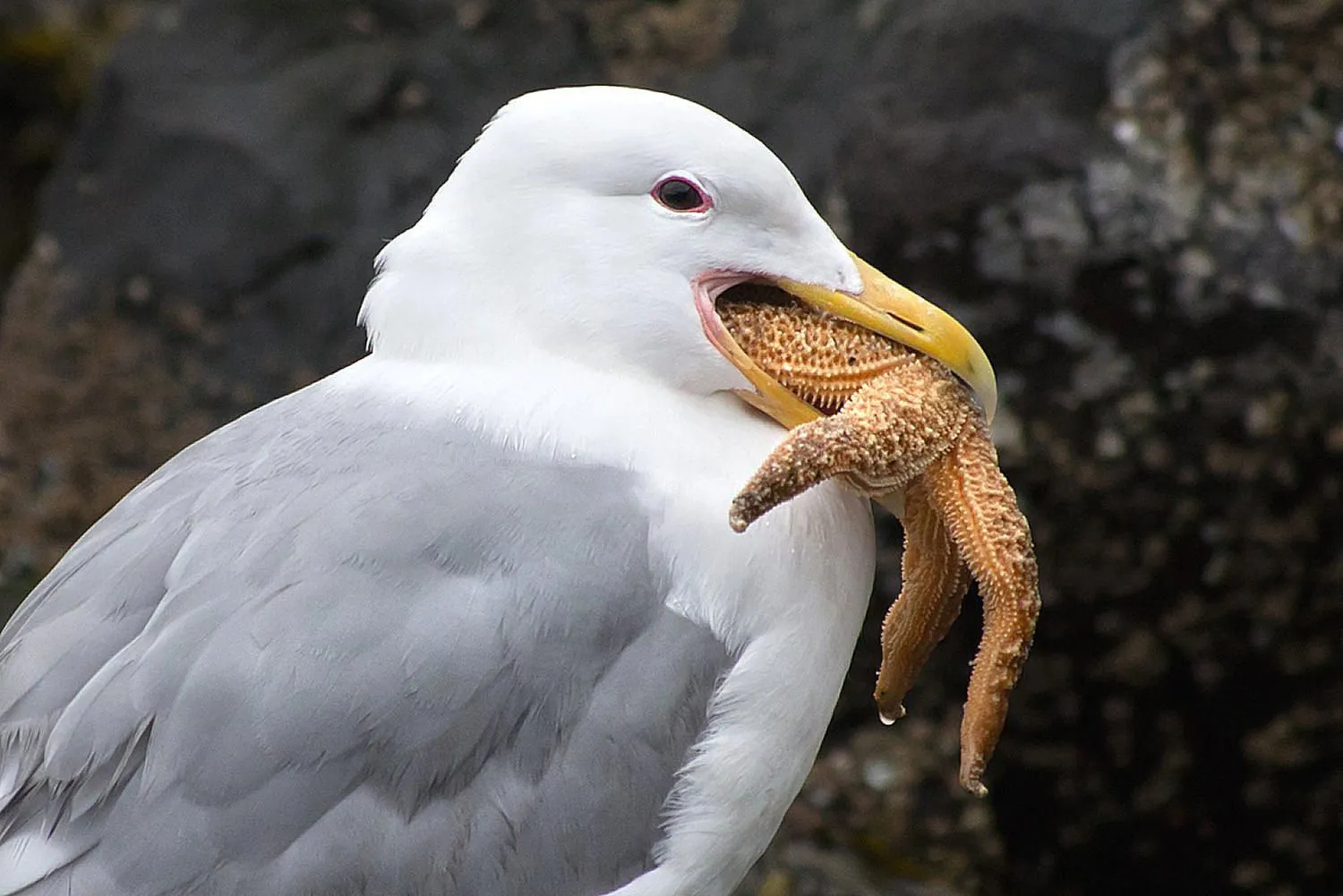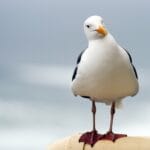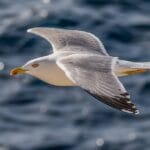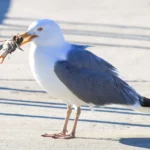Hey there, bird lovers! Dive into the world of seagulls and let’s talk about what they eat. These noisy, graceful creatures may seem like they’re just squawking and swooping around, but they’ve got a fascinating way of finding food in the big wide ocean. Get ready to uncover their secret pantry as we explore the different ways seagulls fill their bellies in the salty seas!
What Do Seagulls Munch On in the Ocean?
Oh, seagulls! We always picture them circling the shores, snatching fries from beachgoers. But hey, they’re way more than just beach scavengers! When they’re hanging out in the ocean, they transform into skilled hunters with a menu that’ll make you say, “Whoa!”
Meet the Ocean Buffet for Seagulls:
- Fish: They’re like feathered fishermen, diving down to grab a quick fishy snack right near the surface.
- Crustaceans: Crabs, shrimp, and barnacles? They’re like crunchy treats for seagulls, and they can’t get enough.
- Mollusks and Gastropods: Clams, mussels, and snails are on the seagull’s list of delicacies, adding some extra flavor to their meals.
- Plankton and Krill: These tiny creatures floating around in the water are like an all-you-can-eat buffet for seagulls.
- Shellfish: Small shrimp and other shellfish are always on the menu, providing a tasty snack for these feathered friends.
- Marine Invertebrates: Jellyfish, worms, and insects are all fair game for these opportunistic eaters. They’re like the ocean’s cleanup crew!
- Other Birds and Eggs: Some seagull species are even fierce predators, targeting other birds and their eggs. It’s the circle of life, after all.
- Worms and Insects: If there’s a juicy worm or insect near the water’s edge, you can bet a seagull will be there to snack on it.
Bonus Fun Fact: Seagulls have amazing stomachs. They can chow down on fish bones, shells, and other tough-to-digest stuff without batting an eye. They’re the ultimate marine stomach warriors!
- Head over What Do Seagulls Eat to know about seagulls’ favorite food.
- Every living being has a unique taste, head over what do seagulls taste like to know about seagull’s taste.
- Winter can be a harsh time for seagulls, go to what do seagulls do in the winter to know how they spend their winter days.
Dietary Adaptations of Seagulls in Different Ocean Environments
Seagulls, those ubiquitous feathered friends of the ocean, astound us with their adaptability to diverse environments. Just like their iconic cries, their dietary habits reflect their exceptional ability to exploit various food sources.
Dietary Mastermind
- Coastal Cuisines: Think of these gulls as seafood lovers, feasting on fish, crabs, and clams in shallow coastal waters. Their aerial skills in diving and surface dipping make them the masters of snatching tidbits.
- Open Water Adventures: Venture into the deep blue, and you’ll find pelagic seagulls gliding effortlessly over water, hunting for fish and squid. They’re also quick to follow fishing boats, scavenging for leftovers like seagull paparazzi.
- Arctic Adaptations: Up in the icy north, seagulls switch to a menu of seabirds, eggs, and marine invertebrates. It’s like a buffet of Arctic specialties.
- Opportunistic Scavengers: Seagulls with a knack for opportunistic dining can be found in landfills, harbors, and even cities. They’re the cleaners of the coast, happily munching on leftovers and discarded items.
What Drives Their Dietary Choices?
- Seasonal Specials: Seagulls are like seafood sommeliers, adjusting their diet with the changing seasons. When fish dwindle in winter, they may snack on more crustaceans.
- Habitat Offerings: The ocean is a vast pantry, and different habitats offer different delicacies. Each seagull community has its unique menu, depending on what’s available in their neighborhood.
- Feathered Competition: Seagulls don’t have it easy. They compete with other birds and predators for food, which shapes their foraging behavior and the choices they make.
The Seagull’s Role in the Ocean Symphony
Seagulls play a crucial role in the delicate balance of marine ecosystems. They help control populations by preying on smaller creatures, and their scavenging habits contribute to nutrient cycling. They’re like the feathered recyclers of the ocean, keeping the shores and waters clean.
In conclusion, seagulls have mastered the art of dietary adaptations, showcasing their versatility and resilience in different ocean environments. They’re not just beachy scavengers; they’re culinary experts that contribute to the health and well-being of our marine ecosystems. So next time you see a seagull, remember the fascinating dietary journey that led it to become the adaptable bird we see today.
Variations in Seagull Diets Across Global Regions
Seagulls might seem like common birds, but when you look closely at their eating habits, you’ll find a fascinating story. These feathered scavengers adapt their diets like no other, eating whatever they can find in their different habitats.
Coastal vs. Inland Cuisine
Coastal seagulls live the high life, diving into the ocean for a seafood feast. Fish, crabs, and other underwater treats are their go-to meals. But their inland cousins have to make do with what’s on land. They munch on bugs, worms, fruits, and even seeds.
Dumpster Divers
Seagulls aren’t picky eaters. When times are tough, they’ll scavenge anything from garbage cans to dumpsters. They’re like the feathered versions of raccoons, always on the lookout for a free meal.
Tough Stomachs
Seagulls have stomachs that would make a crocodile jealous. They can crunch down on bones, shells, and other tough stuff. It’s like a built-in blender in their bodies!
Food Choices: Good and Bad
Most of what seagulls eat is fine for them, but some human food can cause them problems. Sugar and processed stuff can upset their digestion. So, it’s best to keep your salty snacks away from these feathered friends.
A Tale of Adaptability
The different diets of seagulls show us how adaptable these birds are. They can survive in a wide range of habitats, eating whatever the environment has to offer. It’s a testament to the resilience and diversity of these feathered scavengers.
The Role of Scavenging in Seagull Foraging Behavior
Seagulls aren’t just your average beach birds. They’re like the scavengers of the ocean, always on the lookout for a free meal. And that’s not just because they’re lazy; they’ve actually got some pretty special tricks up their wings.
Seagulls have super stomachs that can handle all sorts of stuff, from fish to fries. They’ve got a special “gizzard” that acts like a grinder, breaking down food into tiny bits before passing it to the other parts of their digestive system. That means they can chow down on whatever they find, even if it’s not exactly fresh.
And chow down they do, especially in cities. When humans are around, there’s always plenty of food to be found. Seagulls love nothing more than sneaking a bite of your fries or stealing leftovers from a picnic basket. They’ve become so used to this lifestyle that they’ve even started to hang out in parking lots and garbage dumps.
But not all seagull scavenging is bad news. In fact, it’s actually an important part of the ecosystem. Seagulls help keep beaches and other coastal areas clean by eating up dead fish and other animals that wash ashore. They also poop out these carcasses, which helps fertilize the soil and promote plant growth.
So the next time you see a seagull snatching a bite of your burger, don’t be too annoyed. They’re just doing their job as nature’s cleanup crew. And hey, you could always scare them off by pretending to be a giant bird yourself. They’re not exactly known for their bravery!
Factors That Influence Seagull Scavenging
What makes seagulls start scavenging in the first place? There are a few things:
- Food availability: If there’s plenty of food around, you’ll see more seagulls scavenging. This is especially true in cities and other areas with lots of human activity.
- Competition: Seagulls aren’t the only ones who like to scavenge. They have to compete with other birds, such as crows and ravens, for food. This can make them even more aggressive when it comes to snatching up a bite.
- Human activities: What we humans do has a big impact on seagull scavenging. Overfishing can reduce the number of fish available, forcing seagulls to find other sources of food. And when we leave our trash behind, it’s like a giant buffet for seagulls.
How to Study Seagull Scavenging
Scientists study seagull scavenging behavior to understand how these birds interact with their environment and adapt to changes in food availability. Here are a few methods they use:
- Observation: Researchers can observe seagulls in their natural habitats to see what they eat and how they find food. They might note down the types of food the seagulls eat, where they find it, and how long they spend searching for food.
- Tracking: Scientists can also track seagulls to see where they go and what they’re eating. This can be done using different techniques, such as radio telemetry or GPS tracking.
- Statistical analysis: By collecting data on seagull scavenging behavior and analyzing it, researchers can identify trends and patterns. They can use this information to make predictions about how seagull populations will respond to changes in their environment.
FAQ
Q1: What is the primary diet of seagulls in the ocean?
A1: Seagulls in the ocean primarily consume fish, which they hunt by hovering over the water and diving down to catch their prey near the surface.
Q2: Do seagulls only eat fish in the ocean?
A2: No, while fish is a significant part of their diet, seagulls also consume various other marine organisms, including crustaceans like crabs and shrimp, mollusks like clams and mussels, plankton, krill, jellyfish, and marine invertebrates like worms and insects.
Q3: Do seagulls scavenge for food in the ocean?
A3: Yes, seagulls are opportunistic feeders and will scavenge for food when the opportunity arises. They are known to follow fishing boats and scavenge beaches for fish scraps and other discarded food.
Q4: How do seagulls adapt their diet to seasonal changes in food availability?
A4: Seagulls adjust their diet based on what food is most readily available during different seasons. For example, during winter months when fish are less abundant, they may consume more crustaceans or scavenge for food in human-populated areas.
Q5: Are there any specific types of food that seagulls should avoid eating?
A5: Highly processed or sugary foods, such as those found in human snacks and fast food, can be harmful to seagulls and should be avoided.
- Star Ring Trends: Etsy vs Amazon - March 28, 2025
- Boost Pollinator Habitats: Baby Blue Eyes Sustainable Farming Guide - March 28, 2025
- Protect Big Black Bears: Effective Conservation Strategies - March 28, 2025

















Comments are closed.